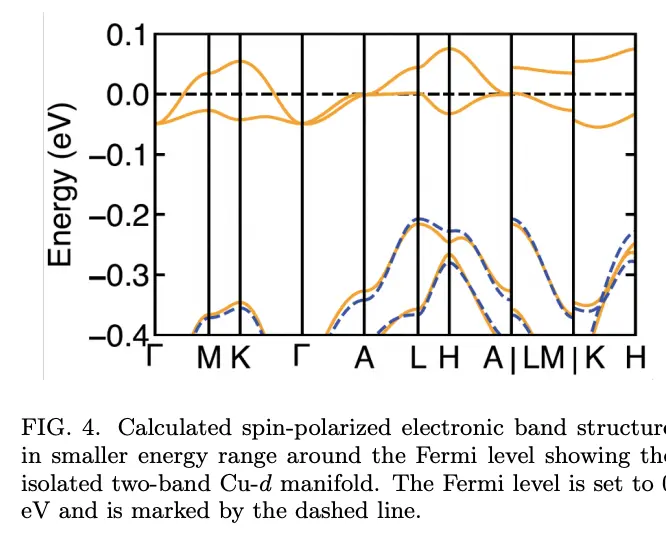Key word here is “Simulations”. Of a phenomenon nobody has reproduced yet, and nobody has a complete understanding of how it might work assuming it actually does.
I’m sorry, simulations are actually more impressive to me, it shows there is a potential theoretical mechanism at play here.
Experiments can go wrong, simulations can go wrong, when they both align that’s interesting.
Simulating something you don’t understand is problematic because you don’t know if your models are correct. I can simulate digging a hole to the core of the planet as long as I get the physics wrong.
I agree, but then again experimenting blindly isn’t entirely better, you might not be measuring what you think you’re measuring.
When both align that’s spooky though.
The alternative isn’t blind experimenting, though. The original research publication is full of lots of holes, and even people working to replicate it are noting that it seems more amateurish than it should be.
So, I’m surprised we went from YBCO to strained lattice, even though I actually hoped we would look closer at strained lattice, I just assumed it was far off, you need a much better model, our ReBCO model is fairly weak, trying to jump to strained lattice seems like it would be much harder.
If we found this, we almost certainly found it through pure luck, we’re 30 years from this kindf of material science, we can barely do single-crystal stuff in bulk, this is theoretically more complex if we hadn’t gotten crazy lucky.
But while I’m skeptical, and want to wait, I’m not willing to turn away a possible golden ticket just because I didn’t expect it in my wonkabar.
I’ve seen 40 years of these kinds of claims come and go. If we actually make a massive breakthrough like this, the lab that makes the discovery is going to be incredibly detailed and meticulous, documenting their exact processes, theories, and efforts to reproduce the material(s) from scratch. It’s not going to be someone publishing notes with major variances and holes in the details.
I guess what I’m saying is when you see enough perpetual machines published in the news, you start to realize that if someone actually had one the first thing they’d do is make another one to confirm, and then plan which island they’re going to buy with their new found riches. And that’s to say nothing of whether it’s commercially viable on a cost or production speed basis. LOTS of advancements die on those vines. Just look at the semiconductor research industry.
Still, nice to see a positive counter to some of the early negative-nellies.
I’m really hoping that this stuff proves out in the end, because then I’ll be able to say I Told You So to the doubting Thomases that immediately jumped on the “nothing ever happens” bandwagon when this was first announced.
Oh and I guess the total revolutionary advancement of human civilization will also be a nice secondary benefit.
As someone who works in power electronics… well, not sure how to feel about this lol. But it will certainly be a while before any products are brought to market.
As a programmer, I already went through the “woah, my whole career path is about to fundamentally change” moment when I first got to toy around with ChatGPT earlier this year. Maybe everyone’s going to get a turn at that. :)
Back when the Em drive had its brush with reproducibility a few years ago I thought one of the most fun side effects would be that the crackpot garage tinkerers would have scored a major feather in their caps and everyone would be paying a lot more attention to their crackpottery going forward. These LK-99 developers are quite a few steps above garage-tinkerers, but they’re still far from respected members of some major institution somewhere so perhaps we’ll get a similar flourishing of interest in off-the-beaten-path theories should this turn out to be a real discovery.
So… about that revolutionary advancement. Now that I know where this notion came from, it’s all the more funny to me.
It’s not a positive counter. That’s the thing. Actually read these reports and threads because they aren’t as glowing as headlines make them appear.
If the results were “does not support LK-99 as a room-temperature superconductor”, that would be a negative result. If they hadn’t done the work at all and there were no results, that would be a neutral result. So this is a positive result. It doesn’t have to be a sweeping confirmation to still be positive.
Running the same simulation isn’t a positive result, it’s running the same simulation. Not running tests at all isn’t neutral, it’s nothing. I’m not saying this needs to be some sweeping confirmation, I’m saying that when you read these reports they aren’t the results that headlines would have you believe.
deleted by creator
This is so degenerate and yet fascinating because I might be slightly degenerate.
Yeah it was really weird earlier when I first found it and I saw detailed scientific discussion and then someone said they were “bullish”. I imagine it would be like seeing a centaur in person for the first time.
Agreed, and me too lol
How did I not know about this website? It’s Batshit crazy and also super fun. People arguing in a stock kinda way about outcomes is genius
https://en.wikipedia.org/wiki/Prediction_market
There are a bunch of these out there!
Yeah this is amazing! I’m surprised it’s not on some internetisbeautiful type page.
Theoretical physicists are notorious for slapping together preprints to provide theoretical justifications/predictions/postdictions for recent hot topics, no matter how sketchy. Cool your jets.
No no no, you’re not getting it. My jets can be room temperature soon. IT’S FINALLY HAPPENING!!
The most important part of the news:
- Lastly, these interesting conduction pathways only form when the copper atom percolates into the less likely location in the crystal lattice, or the ‘higher energy’ binding site. This means the material would be difficult to synthesize since only a small fraction of crystal gets its copper in just the right location.
I’m still pretty skeptical, but I guess we’ll see how the actual reproductions perform.
That would be a bummer, we finally get our RTSC and we can’t make it reliably.
Exciting!








